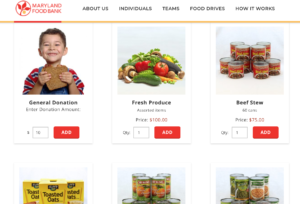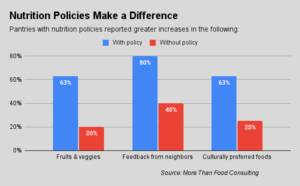It’s fair to say that food banks have a bit of a love-hate relationship with food drives. While they are great for engaging the community and bringing in much-needed food, they are less cost-efficient than cash and can generate heaps of work on the back end in terms of checking expiration dates and shelving. Plus, they tend to turn up sodium-rich, nutrient-light items, sometimes from the dark recesses of cupboards.
Patrick O’Neill, a New Jersey entrepreneur with a charitable bent, saw an opportunity to overhaul America’s most popular form of giving by making it easy for people to donate healthy food, including fresh fruits and vegetables, lean protein and low-fat dairy. His take on food drives, branded #GiveHealthy, is as much a movement as a technology, aimed at getting people to think differently about how to donate food. “Instead of thinking about a can, we want people to think about an apple,” O’Neill said.
The #GiveHealthy approach seeks to retain all the feel-good parts of food drives, while minimizing their undesirable aspects. Instead of raiding their cupboards, donors are asked to visit a website to choose and purchase fresh and healthy foods — say a five-pound bag of apples for $8.50 — from a curated list based on the needs of the recipient food bank. There is no need to lug cans to a collection box, and donors get the satisfaction of knowing they’ve contributed nutritious food.
Food banks benefit even more. #GiveHealthy takes care of everything, purchasing all the food indicated by the donors, giving the food bank a heads-up on exactly what foods to expect, and scheduling an appropriate delivery time. All the food is fresh and new, eliminating the need to check for expiration dates or pay a dumpster bill to cart away damaged goods. If the group doing the donating would like a photo op with the delivery truck, #GiveHealthy will arrange that too. Finally, #GiveHealthy provides a list of who donated to the drive, bolstering future fundraising efforts.
“It’s definitely a lot more organized than regular drives,” said Grace Plihal of Food for Others, a Fairfax, Va.-based hunger relief agency, which has completed one #GiveHealthy food drive and is expecting to wrap up three more. Its first drive generated 1,245 pounds of healthy food. “It’s wonderful,” Plihal said, adding, “We don’t get stuff we don’t need.” At the same time, “people still have the autonomy of selecting what to give.”
Food banks don’t need to do much to participate in #GiveHealthy drives, beyond providing a link to the #GiveHealthy website, which deftly explains to drive organizers how it all works. Their biggest role may be in just getting the word out that the #GiveHealthy drives are a desirable alternative to the traditional drive.
#GiveHealthy, a for-profit company, generates revenue from the difference between the retail prices paid by donors and the wholesale prices at which it purchases the food to be donated. O’Neill estimates that 1,500 #GiveHealthy drives have taken place so far, each generating anywhere from 50 to 50,000 pounds of food.
Over time, O’Neill hopes that the idea of donating healthy food will become second nature. “As a society, we’re more conscious of the connection between food and health,” O’Neill said. “And that trend will continue.”
CAPTION: New Jersey entrepreneur Patrick O’Neill is on a mission to overhaul food drives, America’s most popular form of giving.














